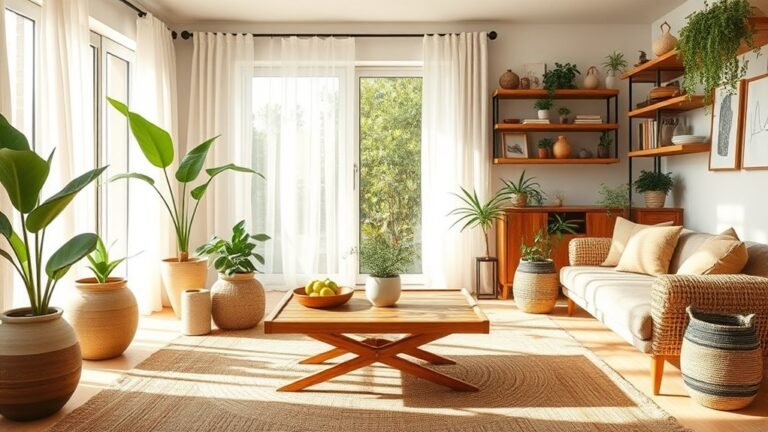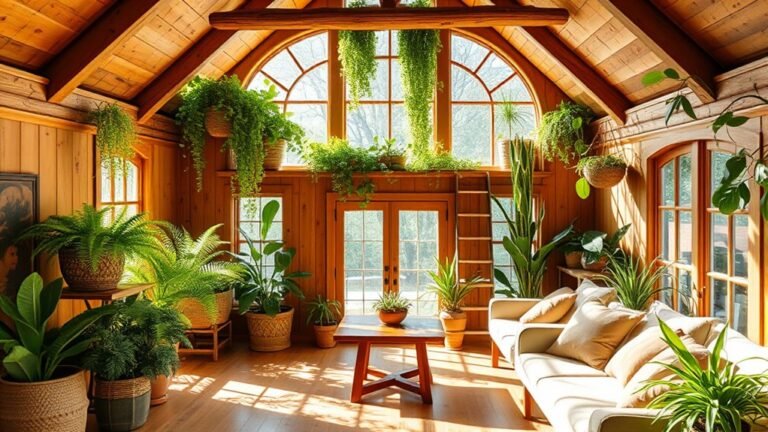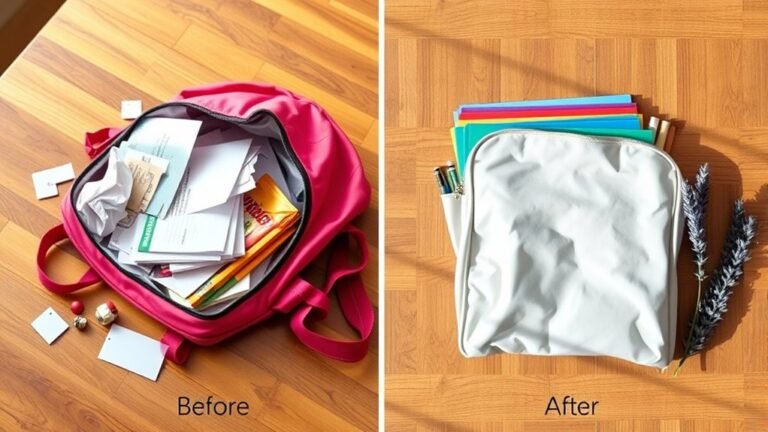Natural Alternatives to Wood
If you want natural alternatives to wood, consider bamboo, which grows fast and is strong yet lightweight. Cork offers great insulation and water resistance while being renewable. Hempcrete provides eco-friendly insulation with a low carbon footprint, and straw bale walls keep your space warm and sturdy. You might also explore reclaimed wood for its unique look and sustainability or mycelium, a biodegradable, fire-resistant option. There’s plenty more to discover about these sustainable materials for your projects.
Bamboo as a Sustainable Building Material

Although it might not be the first material that comes to mind, bamboo is an excellent sustainable building option you should consider. Its rapid growth rate means you won’t be waiting decades for your building materials, giving you the freedom to create quickly and responsibly. Bamboo sustainability is impressive; it absorbs more carbon dioxide and produces more oxygen than many trees, making your construction eco-friendly. When you choose bamboo construction, you’re tapping into a material that’s strong, flexible, and lightweight, perfect for innovative designs that break free from conventional constraints. Plus, bamboo’s natural resilience to pests and moisture reduces the need for harmful chemicals, aligning with your desire to live and build in harmony with nature. Embracing bamboo means you’re making a smart, sustainable choice without compromising your independence.
Cork: Lightweight and Renewable Option
When you’re looking for a lightweight and renewable alternative to wood, cork stands out as a smart choice. Its unique cork properties—like natural elasticity, water resistance, and thermal insulation—make it incredibly versatile. You’ll appreciate how cork’s buoyant yet durable nature lets you use it without feeling weighed down. Plus, cork is harvested without harming trees, so you’re supporting sustainability and preserving forests.
Cork applications range from flooring and wall coverings to furniture and even fashion accessories, giving you freedom to explore eco-friendly designs. Because cork absorbs sound and insulates against temperature changes, it’s perfect for creating comfortable, energy-efficient spaces. Choosing cork means embracing a material that’s renewable, lightweight, and adaptable—ideal if you want to break free from traditional wood and make greener, smarter choices.
Hempcrete for Eco-Friendly Construction

If you’re looking for a sustainable building material, hempcrete offers great benefits like excellent insulation and low environmental impact. You can use it in walls, floors, and roofs by mixing hemp fibers with lime and water. Understanding its application methods will help you make the most of this eco-friendly alternative.
Benefits of Hempcrete
Since you’re looking for eco-friendly construction materials, hempcrete offers several compelling benefits that make it worth considering. Its unique hempcrete properties include excellent insulation, breathability, and lightweight durability, allowing your home to stay comfortable year-round without relying heavily on energy. Hempcrete sustainability shines through its low carbon footprint—hemp plants absorb CO2 as they grow, and the mix itself is naturally biodegradable. Using hempcrete means you’re embracing a renewable resource that reduces environmental impact while giving you freedom from conventional, resource-heavy building materials. Plus, its resistance to mold and pests guarantees long-lasting structural integrity without harmful chemicals. Choosing hempcrete lets you build smart, sustainably, and freely—aligning your values with your living space.
Hempcrete Application Methods
Although hempcrete is gaining popularity for eco-friendly construction, applying it properly requires understanding its unique characteristics. You’ll want to master the right hempcrete mixes and finishing techniques to guarantee durability and breathability. Here’s how you can confidently work with hempcrete:
- Mix Preparation: Combine hemp hurds, lime binder, and water in precise ratios to achieve the ideal consistency.
- Formwork Setup: Use reusable molds or timber frames to shape your walls, allowing hempcrete to set without collapsing.
- Layering: Apply hempcrete in 6-12 inch layers, compacting gently to avoid overcompression that affects insulation.
- Finishing Touches: After curing, apply breathable hempcrete finishing coats for protection and aesthetic appeal.
Straw Bale Walls for Insulation and Strength
Straw bale walls offer an eco-friendly way to boost both insulation and structural strength in your building projects. When you use tightly packed straw bales, you’re tapping into straw insulation’s natural ability to keep interiors warm in winter and cool in summer, reducing your reliance on energy. Beyond insulation, straw strength comes from the dense, fibrous composition, allowing these walls to support loads and resist impacts better than you might expect. You’ll appreciate how straw bale construction lets you create durable, breathable walls while embracing sustainable materials that free you from conventional building constraints. Plus, with proper plastering, your straw bale walls become fire-resistant and moisture-controlled, ensuring longevity without sacrificing the freedom to build naturally and responsibly.
Reclaimed Wood and Salvaged Materials

You can save resources and add unique character to your projects by using reclaimed wood. It’s often sourced from old buildings, barns, or furniture, giving new life to materials that might otherwise go to waste. Knowing where to find salvaged materials helps you make eco-friendly choices without sacrificing quality.
Benefits of Reclaimed Wood
When you choose reclaimed wood, you’re not just selecting a material; you’re embracing a sustainable practice that reduces waste and preserves natural resources. This choice aligns perfectly with modern sustainability practices, letting you enjoy nature’s beauty responsibly. Plus, reclaimed wood has unmatched aesthetic appeal thanks to its unique textures and history. Here’s why you’ll love it:
- Eco-Friendly Impact: Reusing wood cuts down on deforestation and landfill waste.
- Unique Character: Each piece tells a story with rich colors and distinct grain patterns.
- Durability: Older wood is often denser and stronger than new lumber.
- Cost-Effective: You get premium quality without the premium price tag.
Sources of Salvaged Materials
Although reclaimed wood and other salvaged materials can come from various places, knowing where to find quality sources is key to making sustainable choices. You can look to old barns, warehouses, and demolition sites for sturdy reclaimed wood that carries history and character. Salvaged metal often comes from industrial scrap yards or discarded machinery, offering a durable, eco-friendly alternative for your projects. Don’t overlook recycled plastic, which can be sourced from specialized recycling centers and transformed into weather-resistant, low-maintenance materials. By tapping into these sources, you not only reduce waste but also gain freedom from mass-produced, environmentally harmful products. Embracing salvaged materials lets you create unique, sustainable designs while living on your own terms—free and responsible in your choices.
Mycelium: The Future of Biodegradable Building Blocks
One promising natural alternative to traditional wood is mycelium, the root-like structure of fungi that can be grown into strong, lightweight, and fully biodegradable building blocks. You can embrace freedom in design and sustainability by using mycelium composites in your projects. Here’s why mycelium is shaping the future of sustainable architecture:
- It’s renewable and grows rapidly without harming ecosystems.
- Mycelium blocks are fire-resistant and insulate naturally, saving energy.
- They decompose back into the earth, eliminating waste and pollution.
- Custom molds let you create unique, organic shapes that traditional wood can’t match.
Frequently Asked Questions
How Do Natural Alternatives Compare in Cost to Traditional Wood?
You might think the cost comparison between materials would bankrupt you overnight, but it’s not that extreme! Price trends show natural alternatives often start pricier than traditional wood but can save you money long-term with durability and less maintenance. If you value freedom from constant repairs and replacements, these options offer financial peace of mind. So, while upfront costs can be higher, the overall investment often pays off, giving you freedom and value.
Are These Materials Suitable for All Climate Conditions?
You’ll find that climate adaptability varies among materials, so not all are suitable for every environment. Some excel in humidity or extreme temperatures, while others might struggle. Material durability plays a big role here; the more resilient the material, the freer you feel to use it anywhere. It’s all about matching what you choose with your local climate to guarantee long-lasting results without compromising your design freedom.
What Maintenance Is Required for These Natural Building Materials?
When it comes to maintenance, you’ll want to keep an eye on material durability by regularly inspecting for damage or wear. Simple maintenance tips include cleaning surfaces gently, sealing or treating materials to protect against moisture, and addressing any cracks or deterioration promptly. By doing this, you’ll extend the life of your materials and keep your space feeling open and free, without being tied down by constant repairs or replacements.
Can Natural Alternatives to Wood Be Used for Furniture Making?
Did you know that bamboo grows up to 91 cm in just one day? You can definitely use natural alternatives like bamboo or cork for furniture making. They offer amazing design versatility, letting you create unique pieces that reflect your personal style. Plus, their sustainability benefits mean you’re choosing materials that renew quickly and reduce environmental impact. So, go ahead and embrace freedom in your designs while being eco-friendly!
How Do These Materials Impact Indoor Air Quality?
When you choose materials carefully, you can reduce airborne pollutants in your space, making it healthier to breathe. Some natural options release fewer harmful chemicals, so your indoor air quality improves. Plus, these materials often help balance indoor humidity, preventing dryness or excess moisture, which boosts comfort and freedom in your home. So, by picking the right stuff, you create a cleaner, fresher environment where you feel truly free to live and breathe easy.






